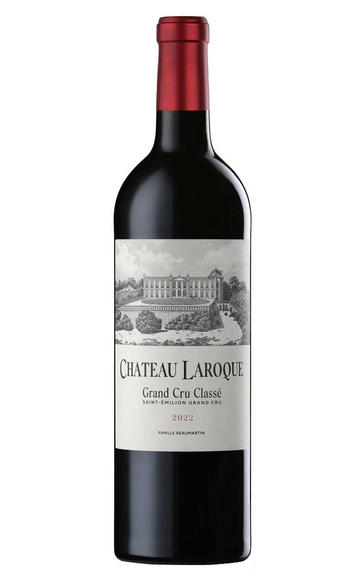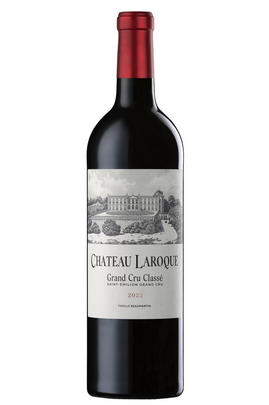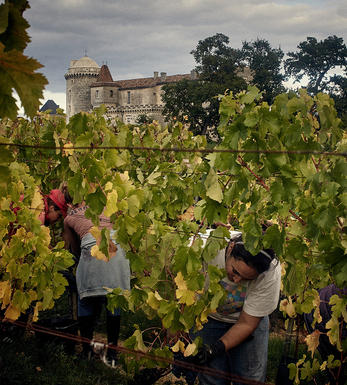
2022 Château Laroque, St Emilion, Bordeaux

Critics reviews
Jane Anson, JaneAnson.com (May 2023)
A blend of 98% Merlot and 2% Cabernet Franc, the 2022 Laroque is deep garnet-purple in color. It prances out with showy scents of warm black plums, blueberry compote, and chocolate-covered cherries, giving way to wafts of underbrush, violets, and Sichuan pepper. The full-bodied palate delivers seriously impressive tension, with firm, ripe, rounded tannins and bags of bright black fruits, finishing long and fragrant.
Drink 2029 - 2059
Lisa Perrotti-Brown, The Wine Independent (May 2023)
Another impressive performance from this estate, the 2022 Laroque offers up aromas of sweet berries, violets, iris and exotic spices, followed by a medium to full-bodied, layered palate with a rich core of fruit that's framed by lively acids, concluding with a taut, chalky finish. Once again, it's the result of a strict selection that sees only 45% of the production released as the grand vin.
William Kelley, Wine Advocate (April 2023)
A very classic Bordeaux with medium to full body, firm tannins and crunchy character, with a linear nature. Currants and blackberries. Sandalwood, too. Fresh.
James Suckling, JamesSuckling.com (April 2023)
Clearly one of the new superstars in the appellation, Château Laroque is located on the cooler, eastern edge of Saint-Emilion and consists of pure, classic upper plateau limestone soils. The estate covers a whopping 54 hectares, which gives director Davie Suire ample flexibility when putting together the Grand Vin.
Looking at the 2022 Laroque, it's a blend of 98% Merlot and 2% Cabernet Franc from healthy yields of 41 hectoliters per hectare, representing just 45% of the total production, and it will spend 16-18 months in 50% new French oak.
This deep purple-hued beauty offers a classic Saint-Emilion bouquet of crème de cassis, graphite, tobacco, and a liquid rock-like sense of minerality. It’s medium to full-bodied, has incredible purity, and ultra-fine tannins. It’s unquestionably another beautiful vintage for this chateau that readers will love.
Jeb Dunnuck, JebDunnuck.com (May 2023)
About this WINE

Château Laroque
Château Laroque is a large St. Emilion estate famous for its stunning 18th century château as well as for the quality of its wines. It is owned by the Beaumartin family and was granted Grand Cru Classé status in 1996.
Its 61 hectares of vineyards (27 of which are used for the Grand Vin) are situated in the commune of St. Christophe des Bardes and it produces nearly 25,000 cases a year. The blend is predominately Merlot based and the wine is aged in oak barrels for 12 months. In the best years it is packed with ripe and plummy fruit supported by a framework of supple tannins and balanced acidity.

St Émilion
St Émilion is one of Bordeaux's largest producing appellations, producing more wine than Listrac, Moulis, St Estèphe, Pauillac, St Julien and Margaux put together. St Emilion has been producing wine for longer than the Médoc but its lack of accessibility to Bordeaux's port and market-restricted exports to mainland Europe meant the region initially did not enjoy the commercial success that funded the great châteaux of the Left Bank.
St Émilion itself is the prettiest of Bordeaux's wine towns, perched on top of the steep limestone slopes upon which many of the region's finest vineyards are situated. However, more than half of the appellation's vineyards lie on the plain between the town and the Dordogne River on sandy, alluvial soils with a sprinkling of gravel.
Further diversity is added by a small, complex gravel bed to the north-east of the region on the border with Pomerol. Atypically for St Émilion, this allows Cabernet Franc and, to a lesser extent, Cabernet Sauvignon to prosper and defines the personality of the great wines such as Ch. Cheval Blanc.
In the early 1990s there was an explosion of experimentation and evolution, leading to the rise of the garagistes, producers of deeply-concentrated wines made in very small quantities and offered at high prices. The appellation is also surrounded by four satellite appellations, Montagne, Lussac, Puisseguin and St. Georges, which enjoy a family similarity but not the complexity of the best wines.
St Émilion was first officially classified in 1954, and is the most meritocratic classification system in Bordeaux, as it is regularly amended. The most recent revision of the classification was in 2012

Merlot
The most widely planted grape in Bordeaux and a grape that has been on a relentless expansion drive throughout the world in the last decade. Merlot is adaptable to most soils and is relatively simple to cultivate. It is a vigorous naturally high yielding grape that requires savage pruning - over-cropped Merlot-based wines are dilute and bland. It is also vital to pick at optimum ripeness as Merlot can quickly lose its varietal characteristics if harvested overripe.
In St.Emilion and Pomerol it withstands the moist clay rich soils far better than Cabernet grapes, and at it best produces opulently rich, plummy clarets with succulent fruitcake-like nuances. Le Pin, Pétrus and Clinet are examples of hedonistically rich Merlot wines at their very best. It also plays a key supporting role in filling out the middle palate of the Cabernet-dominated wines of the Médoc and Graves.
Merlot is now grown in virtually all wine growing countries and is particularly successful in California, Chile and Northern Italy.


Buying options
Add to wishlist
Description
It might be easy to dismiss Laroque as just a crowd-pleaser, but that would be to significantly underestimate the ability of David Suire and his team. Their skill is coaxing such polished, succulent and irresistible fruit and yet retaining a scintilla of mystique that evolves on the palate into rewarding complexity.
Its fascinating terroir, part Astéries limestone, the same as the heart of the St Emilion côtes, then part clay and limestone, produces contrasting elements that combine for a heady mix of sweet hedgerow fruit and Victoria plum, marbled by a sapid sensation of dried herb and oyster-shell freshness.
Merlot 98%; Cabernet Franc 2%
Drink 2027 - 2045
Score: 17/20
Berry Bros. & Rudd (April 2023)
wine at a glance
Delivery and quality guarantee